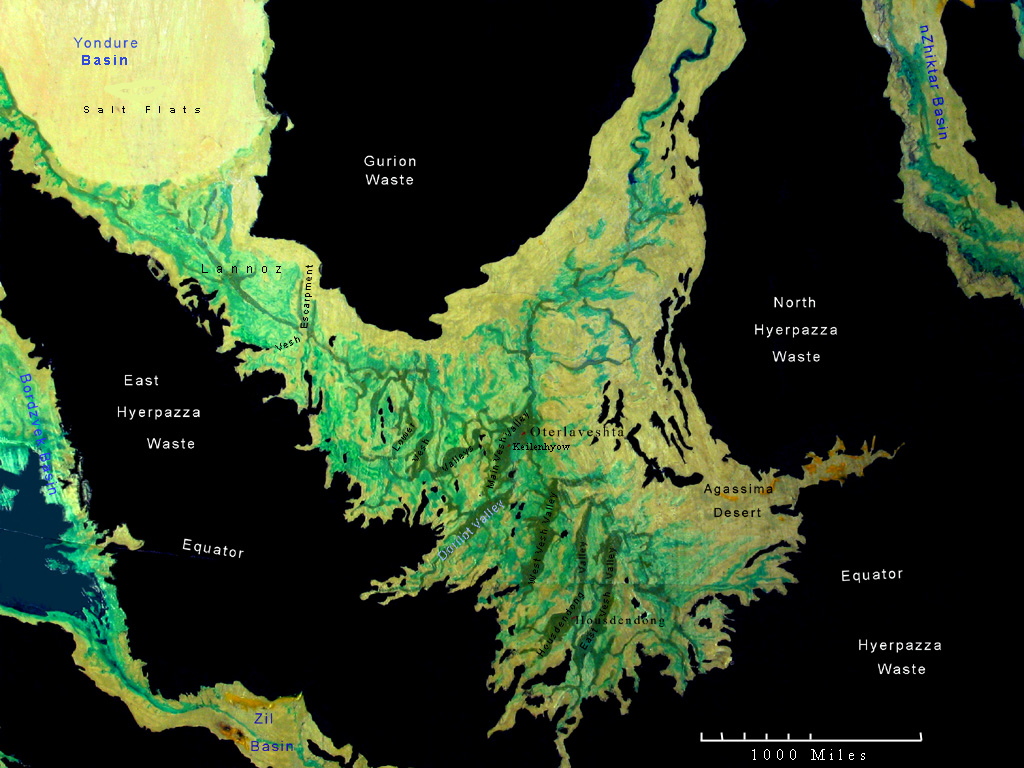

(Back to Geography) (Back to contents)
The whole basin from the escarpment on is an equatorial highland climate with imperceptible seasons and strong weekly temperature swings. Most of the population is concentrated in the valleys in the southern part of the basin where there is ample precipitation, mainly in the form of snow during the dark. The northern parts of the basin are dry and flat, except for right along the North Vesh River.
The Vesh River and it's tributaries are the main transportation arteries in the region. There are few canals compared to other parts of Kassidor, but many large and well-maintained roads. There are only three large cities in the basin and a few smaller ones, giving this one of the lowest population densities of any basin.
The economy of the region is agrarian, with over 90% of the population living on the land. There is not a lot of high technology in the area, but suntower (data) service is available in more than 20 cities.
Life for most of the residents is fairly normal for Kassidor. Most have adequate cultural opportunities. There are many music festivals, outdoor sports are popular and the scenery among the southern valleys is awesome. The population is nearly pure Nordic with a well homogenized mixture of Troll and Yondurian.
If there was contact between Earth and Kassidor in the 1960's, the music and clothing styles introduced to Earth at the time are most similar to those of the Vesh basin. In the 1980's musical styles similar to the Zhlindu basin were also introduced but clothing from that basin would have had legal problems on Earth of that day, as it does on Centorin today. There was no corresponding introduction of any part of Earth's culture to the Vesh or any other basin during that era.
Oterlaveshta, 'Big Vesh' or 'Veshta' for short, is the largest city in the basin by far and is the cultural and economic center of the basin. It has most of the heavy industry, most of the media and finance and most of the centers of Learning. However, the influence of Yondure is strong in this area and those who consider themselves truly educated and cultured have been to that city at some point in their lives.
Within and beyond the Agassima desert is a tribal region that is one of the most primitive on the planet. The tribesmen have almost no contact with the outside world and display all the hostility the Instinct allows. Few outsiders venture there and exploration of the region is spotty.
Humans are relatively new in these highlands, there had been whole histories and civilizations over and again in the deep basins while there were no humans up here other than the occasional nomadic tribe or exploration party. Much of the land had been kept open and clear by wild kedas up until historic times, the fernwood was brought by humans to use for fuel.
The 10th and 11th (4560bc - 4100bc) centuries saw the first explorers from an early Yondurian empire. This was the uplands beyond the land on the far shore of a wide sea at that time. The camp at Oterlaveshta was maintained by trading dried onions from the southest lowlands of the Yondure basin, the area now called Lannoz. At that time a wide sea occupied most of the southeast third of the Yondure Basin.
There were clear signs of permanent and numerous human settlers in this basin by the end of the Energy Age. Between The Fall and modern times, each valley or sub-basin was pretty much isolated from the others and most of these basins had many sovereign feudal states. The Yondurian and Nordic races were entirely homogenized in each sub-basin, with more or less of each in each valley. Most states were more-or-less well-run and the few wars were small and formalized.
The exception was the Main Vesh sub-basin. That was under the control of a single government from earliest times, a government that traced it's roots to pre-energy age Yondure.
Oterlaveshta was a big city by the late 41st (1ad). That was the era when modern times reached this basin complex and the governments dissolved. Of course Dorilot today is much bigger than ‘Vestha was in those days, but it was a big city for it’s day even then. These basins have grown rapidly in modern times and Oterlaveshta today is one of the largest cities at a higher altitude than the Yakhan.
The geology of this basin is ancient. It is full of folded mountains and compression faults that date all the way back to when the planet was much more oblate. As the rotation slowed and the equatorial regions contracted, large parts of the crust were folded and compressed.
In many other equatorial regions of the planet, those processes have been obliterated by later vulcanism, but in the Vesh basin itself there is little volcanic activity today. There is significant vulcanism in the vast Hyerpazza plateau that surrounds the basin on three sides. Most of the rugged peaks in this basin are the result of erosion working on the softer layers among the folds. The crustal rocks in this area are up to three hundred miles deep.